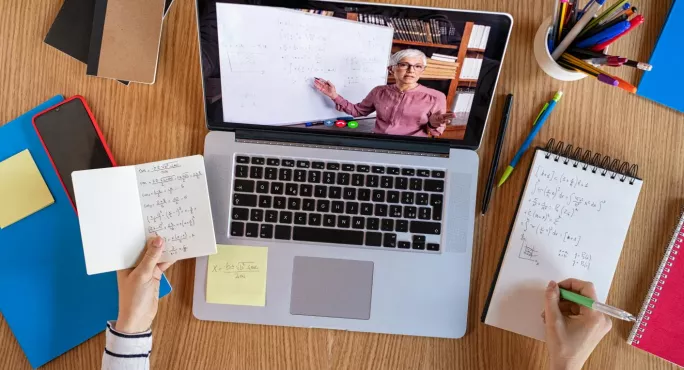Remote teaching: 6 fundamentals for video lessons

Schools across the UK have been asked once again to engage in remote teaching. This means teachers are straight back to hosting remote video lessons for their students.
As such, whether your school asks you to host them live or pre-recorded, or perhaps a mix of both, ensuring you have the right set-up to deliver your lessons is vital.
Of course, this time around teachers will be more au fait with how this works - but it’s still worth reminding yourself of the basics to ensure lessons run as smoothly as possible.
Here are six key things to get right:
1. Check your background
You, no doubt, have a location at home that you used last time around for video lessons and feel confident it works well.
However, it’s still worth ensuring that no new Christmas present or spot of feng shui has changed your background to provide a distraction or, worse, create any awkward or embarrassing conversations - for example, new books on a book shelf or works of art that could be “hilariously” misinterpreted by students.
Ideally, you want a plain, distraction-free background that allows you and your lesson to take centre stage.
2. Make sure the camera angle is straight and stable
Most teachers are experts at this now but it’s worth remembering that your laptop or webcam needs to be stable and pointing straight ahead so you avoid any strange angles that make you look like you are peering up or down.
You also want to avoid the camera shaking around, which could distract your students or make them nauseous.
Don’t be too close to the camera either, as it will not only look a bit unnerving but also may end up muffling the audio if you are too near to the microphone on your device.
3. Use headphones and a microphone
Ideally, use headphones so you can hear clearly any questions that children ask. Meanwhile, a microphone will ensure your audio is as clean and clear as possible.
If you don’t have access to this, it’s not the end of the world as most laptops’ in-built components are reasonably high-spec, but the dedicated kit will help to bring everything up a notch.
4. Act as if you are visible at all times
Having got used to being back in the classroom towards the end of 2020, it may take some readjustment to be back on video again.
One key thing is to remember that you are on display pretty much at all times.
As such, you can’t roll your eyes, yawn or generally look bored because everyone can see you all the time. You’d be surprised how easy it is to forget this, especially if someone else is talking, say, during a senior leadership team meeting. A good rule of thumb is just to assume you are on display at all times until you know the meeting is over and the camera off.
Hopefully, though, the hours spent on Zoom in 2020 mean such awkward moments are avoided.
5. Have resources ready to be shared when required
If you have resources you want to share with students during a video lesson, make sure you know where they are on your desktop, that they have clear file names and, ideally, are already uploaded to the relevant resource hub before you start.
The last thing you want is to be hunting around your downloads folder or browser tabs while students look on.
6. Prepare for the unexpected
As many teachers no doubt discovered throughout 2020, things go wrong on video calls. Just because we’ve been here before does not mean these issues will go away. As such, don’t expect to be a video lesson whizz on day one again or, indeed, after week two or three.
As long as you focus on what you can control, any unexpected moments can generally be ignored or playfully dismissed, allowing learning to continue as best as possible.
Got a top tip you learned during 2020 for making video lessons that bit easier? Then share it below.
You need a Tes subscription to read this article
Subscribe now to read this article and get other subscriber-only content:
- Unlimited access to all Tes magazine content
- Exclusive subscriber-only stories
- Award-winning email newsletters
Already a subscriber? Log in
You need a subscription to read this article
Subscribe now to read this article and get other subscriber-only content, including:
- Unlimited access to all Tes magazine content
- Exclusive subscriber-only stories
- Award-winning email newsletters
